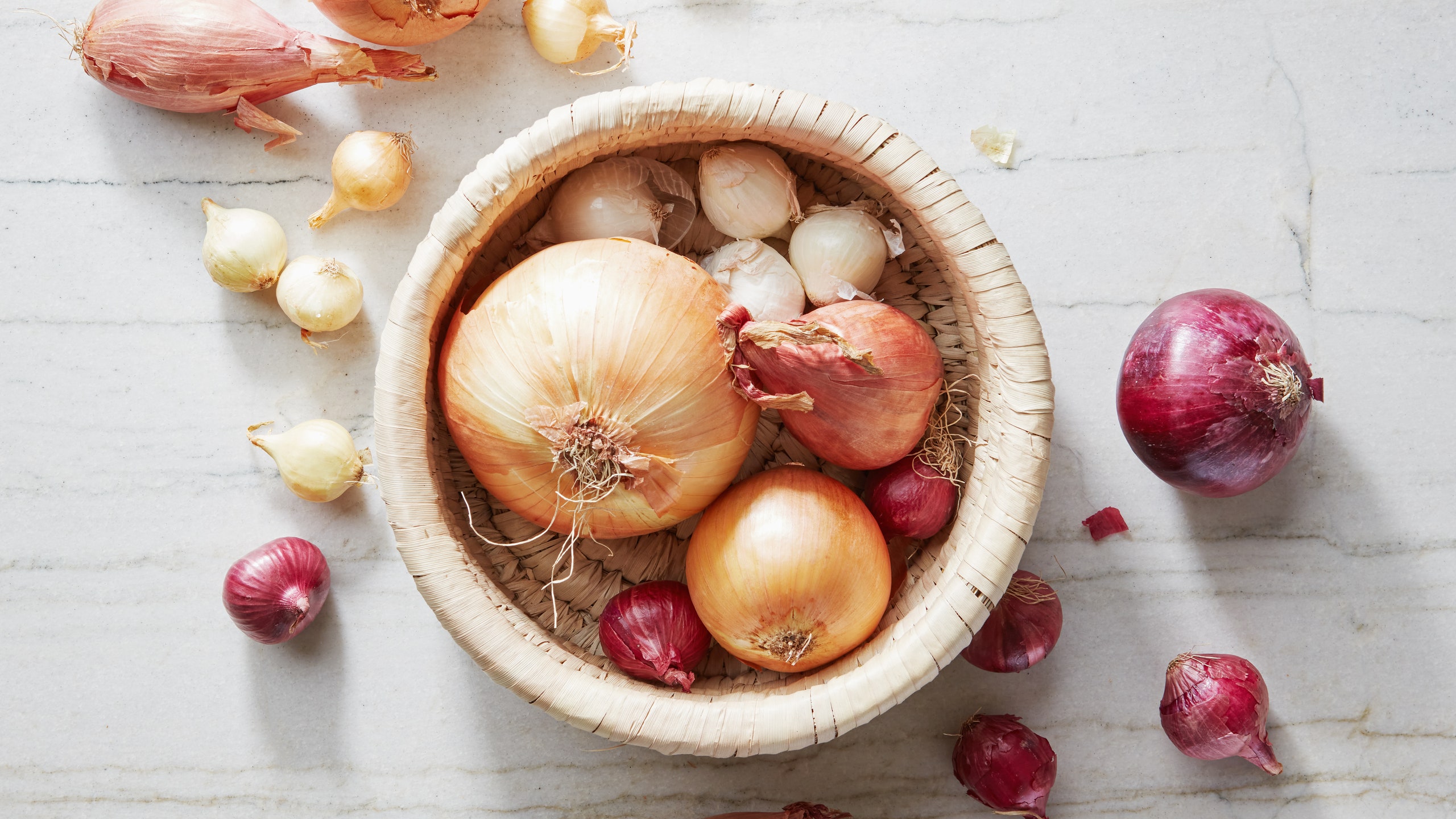I’m a helicopter parent to most of my produce. Are my leafy greens still perky? Does my basil plant need more sun? But when it comes to onions, I’m cool as can be. I don’t hover, poke, or prod—I just assume they’ll be ready and waiting when I need them.
So it wasn’t until recently, when one of my red onions sitting in a sunny spot in my kitchen started sprouting, that I grew curious. What did this mean, and could I have prevented it? Maybe onions aren’t as invincible as I had previously believed. So I reached out to several onion farmers, a food scientist, and a produce field inspector at Whole Foods to learn some expert tips and tricks for storing onions at home.
Where’s the best place to store onions?
Conventional “storage” onions—which include the white, yellow, and red onions you buy at the grocery store or farmstand—should be kept in a cool, dry space away from direct sunlight, moisture, and heat, says Natalie Alibrandi, a London-based food scientist and CEO of Nali Consulting. This could mean in or under a cabinet away from the stove, or, if you’re buying in bulk, in the mud room or garage. As for what to store them in, good ventilation is key.
“They keep best in mesh bags, paper bags, milk crates, baskets, things of that sort,” says Linda Ly, founder of the gardening and urban homesteading blog Garden Betty.
Organic onions, however, fare better in cooler temperatures, says Justin Rich, co-owner of Burnt Rock Farm, a certified organic produce farm in northwestern Vermont. He recommends storing them in the crisper drawer of the refrigerator.
“Especially later in winter, organic onions will tend to sprout if left for weeks at room temperature, while non-organic onions can hold dormancy much longer,” he says.
Because organic onions aren’t sprayed with a chemical sprout inhibitor, they will often sprout sooner, says Rich. He emphasized the need to keep them refrigerated, especially as they get older, but not to be deterred by a harmless sprout or two.
“The sprout is just a little green onion shoot, so don’t be afraid of it,” he says.
How long will onions last?
Storage onions are cured, which means they’re laid out in a warm, dry place post-harvest until the tops have fully dried and the bulbs have formed a papery skin. The curing process greatly increases storage life; in fact, storage onions kept in the aforementioned conditions will last for about three months, says Stacey Cooper, director of agriculture at Cedar Circle Farm and Education Center, a nonprofit educational organic farm in East Thetford, Vermont.
Once they’ve been cut into, that shelf life greatly decreases—and the onion should be kept in the fridge.
“A halved onion will last in the fridge for about five days,” Cooper says. “Finely chopped or sliced onions tend to dry out and lose their flavor more quickly, and may only last a day or two.”
Is there anything onions shouldn’t be stored near?
You may have been told not to store onions near potatoes, and there’s some science behind that advice, says Randy Davidson, a produce field inspector for Whole Foods.
“Onions produce a high level of ethylene, which will cause the potatoes to break down more rapidly,” he said. “In addition, the high moisture content in potatoes can affect the condition of onions when they’re stored in close proximity.”
It’s not just potatoes you need to worry about. Other produce that releases ethylene gas, such as apples, citrus, and bananas, will accelerate an onion’s degradation, as will moisture-rich fruits such as melons and cucumbers, says Alibrandi. An onion’s absorbent nature also means it easily picks up smells.
“It’s best to store them away from aromatic and fragrant foods, like ginger,” she says.
On the flipside, ingredients like butter and cheese can absorb the onion’s flavors, which is why it’s crucial to store cut onions in an airtight container in the fridge.
What causes an onion to sprout?
Remember how onions prefer cool, dark, dry places? Well, the opposite environment—a space that’s warm, moist, or light—will trigger them to sprout. And though they’re still safe to eat (sprout included!) as long as the flesh is firm and there’s no signs of rotting, the clock is ticking.
“The shelf life of an onion fades quickly once it starts to sprout, as the plant pulls energy from the onion bulb to grow a new top, and the bulb shrivels during this process,” Cooper says.
What are the signs that an onion has gone bad?
If you feel a soft top on the onion’s bulb when you push on the paper with your finger, it’s definitely gone bad, Cooper says. Other signs include surface mold (though according to the USDA, black aspergillus mold can simply be washed off) or an off-putting smell.
“It’s pretty hard to miss the odor of a bag of onions that have gone bad,” she said.
Unfortunately, not all signs of rot are as obvious.
“Onions can hold secrets,” Rich said. “Certain common bacterial diseases only affect a single interior layer of the onion and can be challenging to detect before cutting into the bulb.”
One way to prevent this is to store any damaged onions separately, and to use them more promptly.
“Onions with bruises, cuts, or general damage are more susceptible to deterioration and microbial growth,” Alibrandi says.
Luckily for me, my red onion was still safe to eat—but due to the sprouts, I knew its time was running short. To extend its lifespan, Ly suggested I quick-pickle it in vinegar, which would give me about two extra weeks.
From there, the options are limitless: place atop tacos, stuff into sandwiches, or Ly’s personal favorite: add to a watermelon and basil salad.

